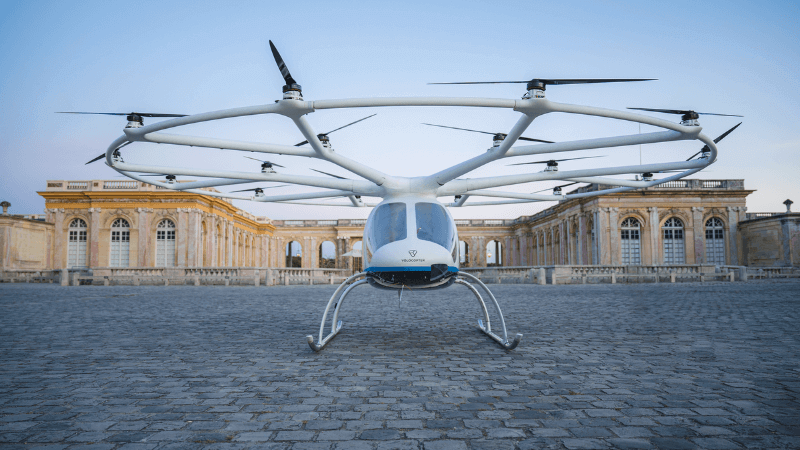

Image Courtesy: Volocopter
Volocopter managed to debut its eVTOL at the Paris 2024 Olympics earlier this month. Although it’s a bit less than taxying athletes around the games, it’s still a major step forward for the company, and for the eVTOL industry more generally.
Below, we’ll look at what this event means for Volocopter as a company and for eVTOL travel in Europe and beyond.
In the early hours of the morning on 11th August, Volocopter’s eVTOL took off from the Palace of Versailles, right in front of the Grand Trianon. After flying around the grounds for a few minutes, it landed safely, marking a successful test flight in a public area.
The event was preceded by validation test flights at a nearby airfield. Both flights were backed by Groupe ADP – Paris Airport’s operator – and the French civil aviation authority. Volocopter had aimed to perform another demonstration flight in central Paris, but it couldn’t get the required certification in time. However, it plans to return to Paris later in 2024 to do this.
The flight itself is an important step forward for Volcopter. More than anything, it’s a clear demonstration of the eVTOL’s design and practical capability – the flown model is the third design of Volocopter’s original concept. Each one brings it closer to the commercial model it’ll roll out.
What held Volocopter back from achieving its full goals in Paris was, unsurprisingly, certification. It’s no secret that eVTOL flight certification is a lengthy process, especially as it’s a novel concept that requires in-depth investigation and authorisation. Volocopter, as with many other eVTOL companies, needs to start from scratch and get an air operator certificate before it moves on to operating an eVTOL.
Operating in Paris (and Europe more widely) is a more complicated process than operating elsewhere in the world. The EASA has different certification requirements from the FAA, for example, as it requires greater maturity in the tested product. However, once this level has been obtained, the rest of the process happens quite quickly.
Regardless, Volocopter’s flight demonstration at Versailles is a great example of the technology in action. The company might not have been able to meet all its goals for its involvement in the Paris Olympics, but showing its aircraft at Versailles was certainly an advancement for the future of AAM.
The impact for Volocopter should be fairly clear, but what about the eVTOL industry more widely? How has the flight demonstration affected how the public sees eVTOL?
Perhaps most importantly, Volocopter’s flight was one of the first to receive a lot of public attention. Sure, there are loads of videos of eVTOLs flying around airstrips and deserts, but seeing one operate in a real public space has a much bigger impact on the aircraft’s commercial viability.
It also marks a big shift in how we perceive the certification process, and how close the actual rollout of this tech actually is. As Volocopter stated, this kind of flight marks a massive amount of effort from all the people involved and is a demonstration of how difficult it can be to actually certify new aircraft technology.
Now we’ve seen it happen in real time in a recognisable place, we can only hope that Volocopter is able to obtain the certification needed for its other planned flights in Paris. If it’s able to return later in the year, we’ll hopefully see some great examples of how an eVTOL will actually operate in an urban environment.
